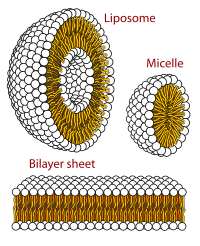
Photo from wikipedia
We have studied the structure of complexes of the cationic surfactant dodecyltrimethylammonium bromide (DTAB) with DNA as a function of surfactant to DNA base molar ratio (R) and salt concentration.… Click to show full abstract
We have studied the structure of complexes of the cationic surfactant dodecyltrimethylammonium bromide (DTAB) with DNA as a function of surfactant to DNA base molar ratio (R) and salt concentration. Small-angle x-ray scattering data show the formation of nematic gels at lower and higher salt concentrations, irrespective of the value of R. Two crystalline phases are observed over intermediate salt concentrations; a square (S) phase for R>3 and a hexagonal (H_{S}) phase for lower R. Electron density maps of these phases show intercalated structures, with DTAB micelles sandwiched between long DNA strands. The composition of these complexes, estimated using elemental analysis, indicates that the micelles are not very long, and they occupy only about half of the interstitial volume between the DNA strands. This phase behavior is strikingly different from that of complexes of DNA with longer chain surfactants cetyltrimethylammonium bromide (CTAB) and tetradecyltrimethylammonium bromide (TTAB), which show only a hexagonal (H) phase over similar ranges of R and salt concentration, the H_{S} structure observed in the present study being a sqrt[3]×sqrt[3] superlattice of the H structure. Madelung energies of the S and H structures, calculated from the electrostatic interaction between their cylindrical constituents, suggest that the former is preferred in DTAB-DNA complexes due to the smaller micellar radius of DTAB. The propensity of DTAB to form short micelles seems also to favor the H_{S} phase at lower R. These results illustrate the important role of micellar size in determining the structure of these two-dimensional macro-ion crystals.
Journal Title: Physical review. E
Year Published: 2022
Link to full text (if available)
Share on Social Media: Sign Up to like & get
recommendations!